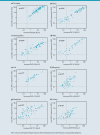Comparison of molecular and extract-based allergy diagnostics with multiplex and singleplex analysis
- PMID: 26709369
- PMCID: PMC4686215
- DOI: 10.1007/s40629-015-0046-4
Comparison of molecular and extract-based allergy diagnostics with multiplex and singleplex analysis
Abstract
Background: ImmunoCAP ISAC 112, is a commercially available molecular allergy IgE multiplex test. Data on the comparison of this rather novel test with extract-based as well as molecular ImmunoCAP singleplex IgE tests is missing.
Objective: To perform a comparison between the ISAC multiplex IgE assay and the ImmunoCAP singleplex test results.
Methods: Serum samples of 101 adults with grass pollen allergy were analysed for sIgE to 112 allergenic molecules represented on the ISAC test as well as to common atopy-related extract-based allergy tests with the ImmunoCAP System (house dust mite [d1], cat [e1], dog [e5], cow's milk [f2], hen's egg [f1], hazelnut [f17], celery [f85], Alternaria alternate [m6], as well as pollen from birch [t3], hazel [t4], mugwort [w6], and ragweed [w1]). Subsequently statistical analysis was performed with the Spearman rank correlation test and the Clopper-Pearson method in order to compare the ISAC multiplex results with the sIgE singleplex results.
Results: The positive percent agreements (PPA) and negative percent agreement (NPA) of corresponding allergens between the ISAC sIgE test and the extract-based singleplex ImmunoCAP results at cutoff 0.1 kUA/l varied between 60-100 % for PPA and 78-97 % for NPA.
Conclusion: When taking into account corresponding allergens molecular testing with the ISAC multiplex test correlates well with ImmunoCAP singleplex results.
Keywords: ISAC; Immuno-CAP; Molecular allergy diagnostics; allergens; component resolved diagnosis; extract-based diagnostics; singleplex multiplex; specific IgE.
Figures
Similar articles
-
Comparison of Molecular Multiplex and Singleplex Analysis of IgE to Grass Pollen Allergens in Untreated German Grass Pollen-Allergic Patients.J Investig Allergol Clin Immunol. 2015;25(3):190-5. J Investig Allergol Clin Immunol. 2015. PMID: 26182685
-
Microarray Analysis Confirms ImmunoCAP-Fluorescence Enzyme Immunoassay Results on Specific IgE in Patients with Atopic Dermatitis and Suspected Birch Pollen-Related Food Allergy.Int Arch Allergy Immunol. 2022;183(8):814-823. doi: 10.1159/000522525. Epub 2022 Apr 4. Int Arch Allergy Immunol. 2022. PMID: 35378542 Free PMC article. Clinical Trial.
-
Peanut components measured by ISAC: comparison with ImmunoCap and clinical relevance in peanut allergic children.Clin Mol Allergy. 2021 Aug 9;19(1):14. doi: 10.1186/s12948-021-00153-w. Clin Mol Allergy. 2021. PMID: 34372856 Free PMC article.
-
ImmunoCAP assays: Pros and cons in allergology.J Allergy Clin Immunol. 2017 Oct;140(4):974-977. doi: 10.1016/j.jaci.2017.05.008. Epub 2017 May 25. J Allergy Clin Immunol. 2017. PMID: 28552762 Review.
-
Selected Technical Aspects of Molecular Allergy Diagnostics.Curr Issues Mol Biol. 2023 Jun 29;45(7):5481-5493. doi: 10.3390/cimb45070347. Curr Issues Mol Biol. 2023. PMID: 37504263 Free PMC article. Review.
Cited by
-
A WAO - ARIA - GA2LEN consensus document on molecular-based allergy diagnosis (PAMD@): Update 2020.World Allergy Organ J. 2020 Mar 7;13(2):100091. doi: 10.1016/j.waojou.2019.100091. eCollection 2020 Feb. World Allergy Organ J. 2020. PMID: 32180890 Free PMC article.
-
Allergy diagnosis from symptoms to molecules, or from molecules to symptoms: a comparative clinical study.World Allergy Organ J. 2018 Sep 11;11(1):22. doi: 10.1186/s40413-018-0199-y. eCollection 2018. World Allergy Organ J. 2018. PMID: 30214659 Free PMC article.
-
Coping with cross-reactive carbohydrate determinants in allergy diagnosis.Allergo J Int. 2016;25(4):98-105. doi: 10.1007/s40629-016-0115-3. Epub 2016 Jun 25. Allergo J Int. 2016. PMID: 27656353 Free PMC article. Review.
-
IgE-Mediated Fish Allergy in Children.Medicina (Kaunas). 2021 Jan 18;57(1):76. doi: 10.3390/medicina57010076. Medicina (Kaunas). 2021. PMID: 33477460 Free PMC article. Review.
-
Diagnosis of fish and shellfish allergies.J Asthma Allergy. 2018 Oct 8;11:247-260. doi: 10.2147/JAA.S142476. eCollection 2018. J Asthma Allergy. 2018. PMID: 30323632 Free PMC article. Review.
References
-
- Canonica GW, Ansotegui IJ, Pawankar R, Schmid-Grendelmeier P, van Hage M, Baena-Cagnani CE, Melioli G, Nunes C, Passalacqua G, Rosenwasser L, Sampson H, Sastre J, Bousquet J, Zuberbier T. A WAO - ARIA - GA(2)LEN consensus document on molecular-based allergy diagnostics. World Allergy Organ J. 2013;6:17. doi: 10.1186/1939-4551-6-17. - DOI - PMC - PubMed
-
- Szecsi PB, Stender S. Comparison of immunoglobulin E measurements on IMMULITE and ImmunoCAP in samples consisting of allergen-specific mouse-human chimeric monoclonal antibodies towards allergen extracts and four recombinant allergens. Int Arch Allergy Immunol. 2013;162:131–4. doi: 10.1159/000353276. - DOI - PubMed
-
- Cabrera-Freitag P, Goikoetxea MJ, Beorlegui C, Gamboa P, Gastaminza G, Fernandez-Benitez M, Ferrer M, Blanca M, Sanz ML. Can component-based microarray replace fluorescent enzimoimmunoassay in the diagnosis of grass and cypress pollen allergy? Clin Exp Allergy. 2011;41:1440–6. doi: 10.1111/j.1365-2222.2011.03818.x. - DOI - PubMed
LinkOut - more resources
Full Text Sources
Other Literature Sources
Miscellaneous


